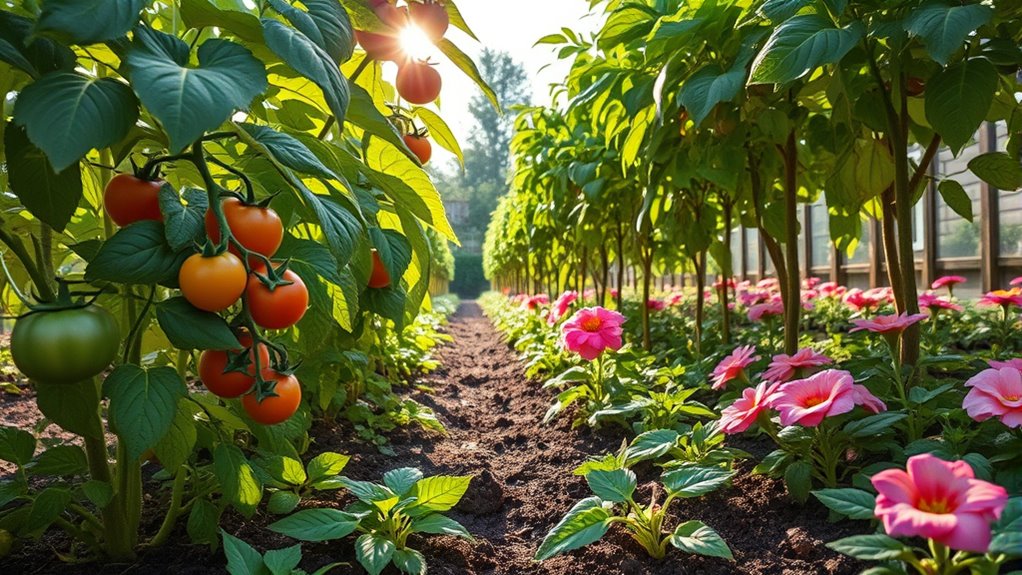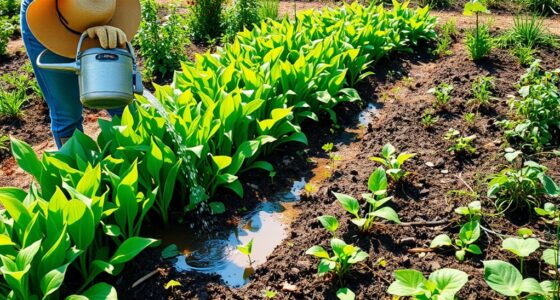To avoid common gardening mistakes, start with proper soil testing and amendment for ideal fertility. Don’t rush into planting without preparing the soil and managing pests early with natural solutions, not just chemicals. Water deeply but infrequently and check soil moisture first. Maintain garden hygiene, promote biodiversity, and avoid overwatering or compacting soil. Focusing on these basics helps build a resilient garden. Keep going, and you’ll discover many other tips for a successful garden journey.
Key Takeaways
- Test soil pH and nutrients before planting to ensure optimal conditions.
- Amend soil with compost or organic matter to improve fertility and structure.
- Avoid overwatering or underwatering; check soil moisture before watering.
- Manage pests early using natural methods and promote beneficial insects.
- Prepare the soil properly and choose diverse plants to enhance resilience.

Starting a garden can be exciting, but beginners often make mistakes that can hinder their success. One of the most common errors is neglecting proper soil preparation. Your garden’s foundation starts with healthy, well-drained soil that provides essential nutrients for your plants. Instead of rushing into planting, take the time to test your soil’s pH and nutrient levels. You might need to amend it with compost or organic matter to improve texture and fertility. Failing to do this can lead to poor plant growth, weak roots, and increased vulnerability to pests and diseases. Good soil preparation also involves loosening the soil to ensure roots can penetrate easily and get enough oxygen. Avoid compacting the soil, as it limits root development and water absorption, making your plants more susceptible to stress and pests. Additionally, understanding beneficial soil microorganisms can greatly enhance your soil’s health and plant growth.
Another critical aspect often overlooked is pest control. Many beginners underestimate the importance of managing pests early on, which can quickly devastate a garden. Instead of waiting until you see damage, adopt preventative measures from the start. Use healthy, pest-resistant plant varieties and encourage beneficial insects like ladybugs and pollinators to balance your garden’s ecosystem. Regularly inspecting your plants allows you to catch infestations early, before they become unmanageable. If pests do appear, opt for natural solutions like neem oil or insecticidal soap rather than immediately turning to chemical pesticides. These methods are safer for your plants, your family, and the environment. Remember, a diverse and healthy garden is less attractive to pests in the first place, so planting a variety of crops and maintaining good hygiene can help reduce pest problems.
Many beginners also make the mistake of overwatering or underwatering their plants, which can compound issues related to pests and soil health. Proper watering techniques are vital: water deeply but infrequently to encourage strong root growth, and always check the moisture level of your soil before watering. Overwatering creates a damp environment that invites fungal diseases and pests like root maggots, while underwatering stresses your plants, making them more vulnerable to pest attacks and disease.
In essence, successful gardening starts with good soil preparation and proactive pest control. These steps set the stage for healthy growth and make your gardening efforts more rewarding. By paying attention to your soil’s needs and keeping pests in check early on, you’ll build a resilient garden that can thrive through seasons, reducing setbacks and fostering a more enjoyable gardening experience.
Frequently Asked Questions
How Often Should I Water My New Plants?
You should establish a consistent watering schedule to guarantee your new plants stay healthy. Typically, water them when the top inch of soil feels dry, which might be every couple of days or daily in hot weather. Proper plant hydration is vital, so monitor your plants closely, especially during heat waves. Adjust your watering frequency based on the plant type, soil, and weather conditions to keep them thriving.
What Soil Type Is Best for Beginner Gardeners?
Did you know that about 60% of successful gardeners swear by loamy soil? For beginners, this soil type offers a perfect balance of drainage and nutrients. You should focus on soil amendment by adding compost regularly, which boosts fertility and improves texture. Incorporate compost addition into your gardening routine, and you’ll create a healthy environment for your plants to thrive. Loamy soil, combined with compost, makes planting much easier and more rewarding.
When Is the Ideal Time to Plant Different Vegetables?
You should plant vegetables based on seasonal planting guides and frost dates. For spring crops, wait until after the last frost, usually in late April or early May in many areas. For fall vegetables, plant in late summer, about 6-8 weeks before the first expected frost. Keep an eye on local weather forecasts and your area’s frost dates to make certain your plants have the best chance to thrive.
How Do I Prevent Pests Without Using Chemicals?
Pests can be a gardener’s nightmare, yet you don’t need harsh chemicals to keep them at bay. Instead, embrace natural pest control methods like attracting beneficial insects and practicing companion planting. By planting herbs like basil or marigolds near vegetables, you create a barrier that confuses pests. This balanced approach not only protects your garden but also promotes healthy, thriving plants without risking your environment or your health.
What Are Signs That My Plant Is Overwatered?
If you notice your plant’s leaves turning yellow or wilting despite watering, it might be overwatered. Signs of watering stress include soggy soil, a foul smell, and root rot, which can severely damage roots and hinder nutrient absorption. To prevent this, make certain proper drainage and only water when the top inch of soil feels dry. Avoid overwatering, and your plant will stay healthier and thrive.
Conclusion
Avoiding common gardening mistakes can save you time, money, and frustration. Remember, over 60% of beginner gardeners report giving up within the first year due to simple errors like overwatering or poor soil prep. By learning what not to do and taking small, informed steps, you’ll enjoy a thriving garden that brings beauty and satisfaction. Stay patient, keep experimenting, and don’t be afraid to learn from your mistakes—success is just around the corner!









